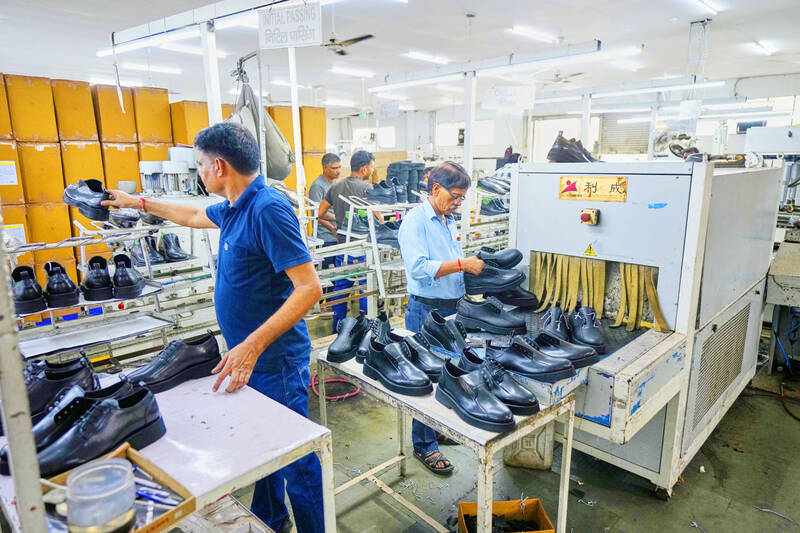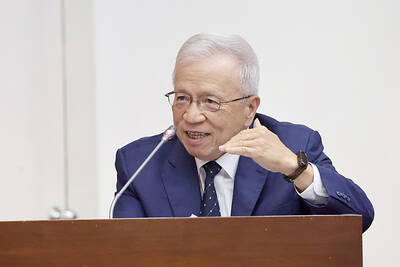Steep US tariffs on a range of Indian products took effect yesterday, threatening a steep blow to India’s overseas trade in its largest export market.
US President Donald Trump had initially announced a 25 percent tariff on Indian goods, but earlier this month he signed an executive order imposing an additional 25 percent tariff due to India’s purchases of Russian oil, bringing the combined tariffs imposed by the US on its ally to 50 percent.
The Indian government estimated the tariffs would impact US$48.2 billion worth of exports. Officials have warned the new duties could make shipments to the US commercially unviable, triggering job losses and slower economic growth.

Photo: AP
India-US trade relations have expanded over the past few years, but remain vulnerable to disputes over market access and domestic political pressures. India is one of the fastest-growing major global economies and it might face a slowdown as a result.
Estimates by New Delhi-based think tank Global Trade Research Initiative (GTRI) suggested labor-intensive sectors such as textiles, gems and jewelry, leather goods, food and vehicles would be hit hardest.
“The new tariff regime is a strategic shock that threatens to wipe out India’s long-established presence in the US, causing unemployment in export-driven hubs and weakening its role in the industrial value chain,” GTRI founder and former Indian trade official Ajay Srivastava said.
The US has for now exempted some sectors, such as pharmaceuticals and electronic goods, from additional tariffs, bringing some relief for India as its exposure in these sectors is significant.
Groups representing exporters warn that new import tariffs could hurt India’s small and medium enterprises that are heavily reliant on the US market.
“It’s a tricky situation. Some product lines will simply become unviable overnight,” Federation of Indian Export Organizations director general Ajay Sahai said.
The tariffs come as the Trump administration continues to push for greater access to India’s agriculture and dairy sectors.
India and the US have held five rounds of negotiations for a bilateral trade agreement, but have yet to reach a deal. That is largely because New Delhi has resisted opening these sectors to cheaper US imports, citing concerns that doing so would endanger the jobs of millions of Indians.
Indian Prime Minister Narendra Modi has vowed not to yield to the pressure.
“For me, the interests of farmers, small businesses and dairy are topmost. My government will ensure they aren’t impacted,” Modi said at a rally this week in his home state of Gujarat.
Modi said the world was witnessing a “politics of economic selfishness.”
A US delegation canceled plans to visit New Delhi this week for a sixth round of trade talks.
The Indian government has begun working on reforms to boost local consumption and insulate the economy.
It has moved to change the goods and services tax, or consumption tax, to lower costs for insurance, cars and appliances ahead of the major Hindu festival of Diwali in October.
The Indian Ministry of Commerce and Industry and the Ministry of Finance are discussing financial incentives that would include favorable bank loan rates for exporters.
The Indian Ministry of Commerce and Industry is also weighing steps to expand exports to other regions, particularly Latin America, Africa and Southeast Asia.

JITTERS: Nexperia has a 20 percent market share for chips powering simpler features such as window controls, and changing supply chains could take years European carmakers are looking into ways to scratch components made with parts from China, spooked by deepening geopolitical spats playing out through chipmaker Nexperia BV and Beijing’s export controls on rare earths. To protect operations from trade ructions, several automakers are pushing major suppliers to find permanent alternatives to Chinese semiconductors, people familiar with the matter said. The industry is considering broader changes to its supply chain to adapt to shifting geopolitics, Europe’s main suppliers lobby CLEPA head Matthias Zink said. “We had some indications already — questions like: ‘How can you supply me without this dependency on China?’” Zink, who also

At least US$50 million for the freedom of an Emirati sheikh: That is the king’s ransom paid two weeks ago to militants linked to al-Qaeda who are pushing to topple the Malian government and impose Islamic law. Alongside a crippling fuel blockade, the Group for the Support of Islam and Muslims (JNIM) has made kidnapping wealthy foreigners for a ransom a pillar of its strategy of “economic jihad.” Its goal: Oust the junta, which has struggled to contain Mali’s decade-long insurgency since taking power following back-to-back coups in 2020 and 2021, by scaring away investors and paralyzing the west African country’s economy.

BUST FEARS: While a KMT legislator asked if an AI bubble could affect Taiwan, the DGBAS minister said the sector appears on track to continue growing The local property market has cooled down moderately following a series of credit control measures designed to contain speculation, the central bank said yesterday, while remaining tight-lipped about potential rule relaxations. Lawmakers in a meeting of the legislature’s Finance Committee voiced concerns to central bank officials that the credit control measures have adversely affected the government’s tax income and small and medium-sized property developers, with limited positive effects. Housing prices have been climbing since 2016, even when the central bank imposed its first set of control measures in 2020, Chinese Nationalist Party (KMT) Legislator Lo Ting-wei (羅廷瑋) said. “Since the second half of

Taiwan Semiconductor Manufacturing Co (TSMC, 台積電) received about NT$147 billion (US$4.71 billion) in subsidies from the US, Japanese, German and Chinese governments over the past two years for its global expansion. Financial data compiled by the world’s largest contract chipmaker showed the company secured NT$4.77 billion in subsidies from the governments in the third quarter, bringing the total for the first three quarters of the year to about NT$71.9 billion. Along with the NT$75.16 billion in financial aid TSMC received last year, the chipmaker obtained NT$147 billion in subsidies in almost two years, the data showed. The subsidies received by its subsidiaries —